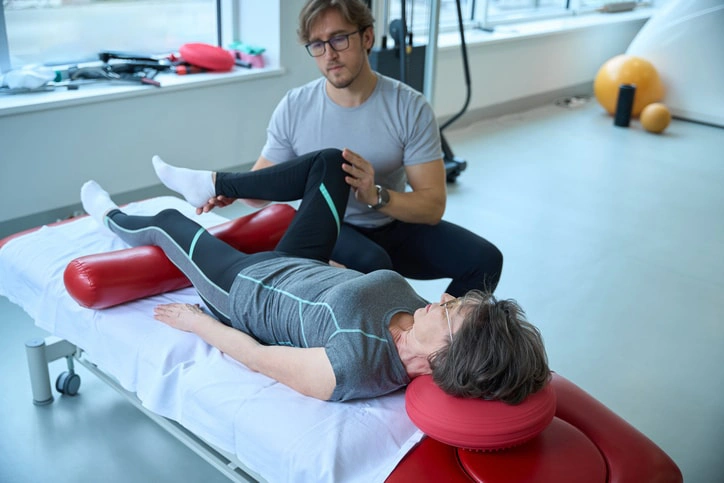Occupational therapy is an allied health service which focuses on helping a person to overcome challenges presented by an injury, disability or disorder to be able to do everyday tasks and participate in activities they enjoy.
Occupational therapy covers a person’s physical, cognitive and emotional needs, abilities and challenges. Therapy aims to help a patient to increase and maintain independence and community mobility, and facilitate engagement in work, school or recreation.
Because occupational therapy covers such a wide area of practice, many occupational therapists choose to focus on a particular area of occupational therapy.
We’ve put together this guide to types of occupational therapy practice to explain the different areas of occupational therapy.
Types of occupational therapists
Many occupational therapists are generalists, working across a range of different types of patients and occupational therapy needs. General occupational therapy practice is helpful for treating the whole person (an essential element of occupational therapy) and often general occupational therapy is more accessible.
All types of occupational therapists work to enable independence, to support patients to undertake everyday activities such as self care, and improve their ability to achieve meaningful activities in their life.
In Australia, there are no official occupational therapy specialties and occupational therapists can’t call themselves a ‘specialist’. However, some occupational therapists have special expertise in a particular type of:
patient, for example, children or older people
setting, for example, hospital, school, or workplaces
injury, disability or disorder, for example, mental health issues, autism spectrum disorder or sports injuries.
These are called areas of practice, and it can be valuable to find an occupational therapist who has this extra knowledge and experience that’s suited to your situation.
Areas of practice in occupational therapy
While there are no defined specialities in occupational therapy, here are some of the more commonly recognised types of occupational therapy practice.
Disability Occupational Therapy

Working in both community and clinical settings, occupational therapists who practice in the area of disability aim to increase independence and improve quality of life, in line with the patient’s personal goals. They prescribe aids, such as mobility equipment, and recommend environmental modifications, such as ramps or improved lighting. Occupational therapists work with people who have physical and mental disabilities, including, for example:
Hearing or visual impairment
Cerebral palsy
Intellectual disability
Mobility impairment or other physical disability
Chronic disease or disorder.
Disability occupational therapists will also be familiar with the NDIS, which can be helpful.
Mental health Occupational Therapy
Mental health occupational therapists help people recover from mental illness, psychosocial disability and mental health challenges such as anxiety, depression, bipolar disorder or schizophrenia.
They focus on helping a person to engage in meaningful activities and to support their mental health with positive lifestyle choices such as healthy eating. They often have expertise in psychological techniques.
A mental health occupational therapist can help with:
socioemotional skills
home management skills
work skills
community engagement and participation in recreational activities
psychoeducational and coping skills
goal setting.
They can also work with other health professionals in the mental health care system and the NDIS.
Environmental Modification and Aids
Some occupational therapists have specific expertise in work, school or home modifications to remove barriers that prevent patients from achieving independence doing everyday tasks in these spaces.
Occupational therapists will do site visits and recommend changes to the structure, layout or design of the home or building.
Occupational therapists may also be experts in aids such as mobility devices (wheelchairs or motorised mobility devices), prosthetic limbs, adaptive equipment (communication boards or walkers) or assistive technology (like screen readers or special-purpose computers).
The expertise of occupational therapists can be essential in choosing the right device or equipment, setting it up appropriately and training the user so that they can get the most out of their equipment and use it safely.
If you need environmental modifications, this can sometimes be supported by NDIS funding, review our blog on Navigating NDIS Occupational Therapy to find out more.
Occupational Therapy for Neurology and Acquired Brain Injury
Some occupational therapists provide support to those who have neurological conditions or injuries such as:
stroke
cerebral palsy
dementia
traumatic brain injury
spinal cord injury
These occupational therapists have particular experience and expertise in managing cognitive problems and developing a program of therapeutic activities that will assist someone with an acquired brain injury or neurological condition to improve their everyday living.
Physical Rehabilitation Occupational Therapy

Occupational therapists commonly work in the area of physical rehabilitation following an injury or operation.
The rehabilitation occupational therapy process can involve:
Hands-on assessment and treatment, for soft-tissue injury, or loss of soft-tissue function
Hand therapy
Movement analysis
Managing risk of re-injury
Pain management
Recommending aids that can help with mobility and everyday activities during rehabilitation
Teaching self-management and adapting to new ways of living
Removing barriers to local community interaction and meaningful activities.
Injury recovery can be a stressful and emotional process, sometimes with ongoing trauma from the original incident, so occupational therapy’s holistic, person-centred perspective means that supporting mental health is as essential as the physical rehabilitation.
Occupational therapists will liaise with other professionals involved in the person’s medical care and rehabilitation to ensure care is coordinated.
Occupational Therapy for Disability
Occupational therapy for disability helps individuals with physical, cognitive, or sensory impairments live more independently and meaningfully. It supports people with various disabilities, including:
Mobility challenges
Intellectual or developmental disabilities
Sensory impairments, such as vision or hearing loss
Neurological conditions, like cerebral palsy
Chronic health conditions
The focus is on building independence by developing skills, recommending assistive devices, and making environmental modifications, such as installing ramps or grab rails, to improve accessibility and safety.
Therapists collaborate with individuals, families, and support networks to create strategies that enable participation in self-care, work, and community activities. Therapy aligns with personal goals to ensure meaningful engagement and improve quality of life.
Occupational therapists also assist with navigating systems like the NDIS, ensuring access to funding for services and equipment. This holistic approach helps people with disabilities gain confidence, independence, and greater well-being.
Occupational or Vocational Rehabilitation
Occupational therapists who practice in the area of occupational or vocational rehabilitation focus on a patient’s work environment and capacity, so that the person can work as comfortably and productively as possible. They may have a disability or chronic illness, or be returning to work following an injury or medical event.
They focus on the functional requirements of the role and providing therapy and strategies to meet these requirements successfully in the workplace. They also provide recommendations about assistive technology, adaptive equipment and environmental modification to ensure the workplace is suitable for the employee’s needs.
The occupational therapist also educates and advises the employer about how they can support their employee, which can range from inclusive team practices and flexible work hours to provision of assistive devices or accessible workplace design.
Occupational or vocational rehabilitation occupational therapists may work in the government, private and insurance sector to help prevent workplace injuries, or to support employees with their return to work.
They also work with people who have long term disabilities to prepare to enter the workforce for the first time.
Paediatric Occupational Therapy

The paediatric occupational therapy area of practice works with children across a range of developmental issues, disorders and disabilities, from the neonatal stage to the teenage years.
Paediatric occupational therapists can help children to overcome temporary conditions, such as developmental delays with speech or fine motor skills. They also work with children who have ongoing or chronic conditions, such as ADHD, genetic disorders or cognitive/physical disabilities.
Occupational therapy focusses on helping children to perform age-appropriate tasks in the areas of self care, school, and community participation (such as in sport or other recreational activities).
Paediatric occupational therapists will consider the everyday activities children need to do in the school/childcare and home environment, recommending modifications, assistive equipment and assistive devices as necessary.
Pain Management
Acute and chronic pain can need expert help to manage, with occupational therapists able to provide a range of interventions to assist with pain management.
Occupational therapists will bring a holistic perspective to pain management, focusing on:
Decreasing pain states
Improving self-management, with neuroscience-based education, sensory input and processing techniques and activity management strategies
Removing barriers to re-engagement with work or school.
Occupational therapy will help those with chronic pain to improve their ability to do everyday activities, and integrate tasks that can help manage the pain.
Working with older people
As people age, they may find they need to do things differently due to age-related conditions such as:
poor balance or coordination
memory loss or confusion
vision or hearing loss.
Occupational therapists in the geriatric wellness area of practice work with older people to enable them to safely continue doing the things that are important to them.
Small changes could be switching to large-text or audio books due to low vision, and larger changes could involve home modifications so an older person with poor balance can keep living independently in their own home environment.
Occupational therapists also recommend physical and mental exercises to maintain cognitive and physical function.
Occupational therapists work with older people in aged care facilities, in clinical practice and in the community.
Acute hospital
Occupational therapists work in a hospital setting to help patients increase their functional capacity during their recovery in hospital. The goal here is to prepare hospital patients to be able to do the everyday activities they need to do to leave hospital and function in their home environment.
Some of the more common conditions hospital occupational therapists have expertise in are post-surgery recovery, physical injury, stroke or cardiac rehabilitation.
Occupational therapists will:
oversee gradual activity progression following a medical event or accident
assist with building self care skills, so patients are able to go to the toilet and shower as independently as possible
do a home assessment and provide assistive equipment for the return home
educate family and friends on how to provide support and care at home.
Palliative care
Occupational therapy can provide people with terminal illness the help they need to live as independently as possible and achieve what they want within the time they have left.
Everyone has different preferences about what’s important to them, whether it’s to keep doing normal activities, such as work or school, for as long as possible, or to tick items off a bucket list, palliative occupational therapy is about removing barriers wherever possible and enabling a person to fulfil their end-of-life wishes.
A life-limiting illness often means the person’s needs and functional capabilities are changing constantly as their disease progresses, and occupational therapists will need to do ongoing assessment and keep making changes – for example, to ensure the home environment is suitable. Most people prefer to live at home as long as possible and occupational therapy can help enable this.
Autism

Occupational therapy helps adults and children with autism spectrum disorder to address tasks that are difficult. This may be through using assistive equipment and aids, by finding a better way of doing things, or by modifying the environment to remove obstacles.
Occupational therapists with expertise in the area of autism spectrum disorder have specialised knowledge of working with autistic people and solving common challenges they face.
Because autistic people are all different, with varying capabilities and challenges, occupational therapy professionals will provide tailored support that accounts for each person’s situation and preferences. Often occupational therapists need to draw on their problem-solving skills to develop a brand-new solution for a unique issue.
How can we help?
Goal Coach has a whole team of occupational therapists, some of whom are generalists, and others with general experience as well as deeper expertise in one (or more) of the occupational therapy areas of practice. With no waiting list, you can get started straight away but booking your free 15-minute appointment to talk about your occupational therapy needs.










